Monotonous Sounds
You can make BARBARA behave as a traditional monotonous metronome by pressing first the New button, and then the grey 1/4 button, and finally the Done button.
This way you get the following sequence of a single bar, which you can play with the Loop button.

Another possibility to make monotonous metronome sound is to use the Quick Start button (two dots in lower right corner). In the Quick Start menu you can select the grey button with signature 2/4.
See section Rare Time Signatures to find information about the grey buttons.
Basics
BARBARA plays sequences of metronomic bars (measures). In the picture below a sequence named "TICK tock tock tock" is loaded into the metronome. The sequence has only a single 4/4 bar, but it is considered a sequence in BARBARA.
If you pressed the Loop button when a single 4/4 bar is shown, BARBARA would play: tick, tock, tock, tock, tick, tock, tock, tock, tick, tock, etc.

All sequences of bars in BARBARA are named. If you create an own sequence with the New button, BARBARA will give it an artificial name that starts like "Sequence 2025-09- ..."
While selecting bars to your own sequences, you will find the Name button with which you can replace the artificial sequence names with more descriptive names. All sequences of bars in BARBARA can be found, and played later, by using the Lists button.
There are many YouTube videos that demonstrate important features of BARBARA.
The basic operation is that when BARBARA is showing a sequence of bars, the shown bars can either be played once or repeated.
The third button above is the Quick Start button which opens a menu for basic rhythms. The Play 1 and Loop buttons will change to Pause and Stop buttons when BARBARA is operating.
Basic Bars


After pressing the New or Edit buttons in the main view, you will see pages with buttons that you can press to create sequences of bars.
You can change to other pages of bar buttons by moving your finger in left-right direction on the screen.
Although all these buttons are called bar buttons, the buttons in which the upper numeral is 1 can be considered as single notes which the metronome plays. See section Rare Time Signatures to find information about the grey buttons.
Additions
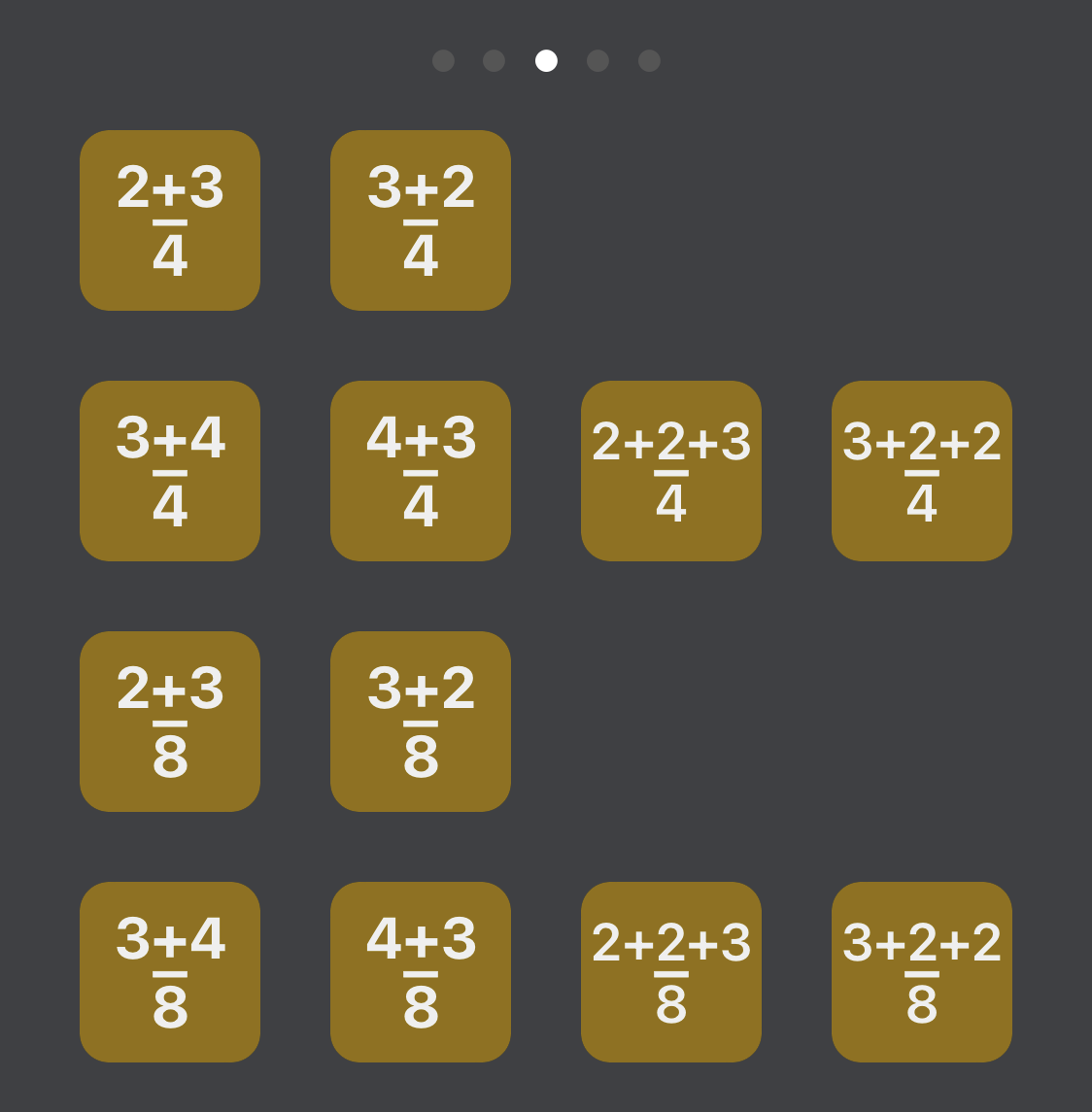
There are buttons that make it easier to play the time signatures 5/4, 7/4, 5/8 and 7/8 as additive rhythms.
For example, if you liked to play six 5/8 bars so that the first and fourth beats were emphasized, you could simply program the following.

The same could be achieved without the additive bars in the following way.

Alternative Sounds

You can make BARBARA use alternative (or secondary) metronome sounds.
When you see a button in which time signature is marked with dark color, you know that the button will make a bar with alternative metronome sounds.
BARBARA can use four different sounds. We can think that a 4/4 bar programmed with a light-colored time signature makes the sound: tick, tock, tock, tock. Then, also a 4/4 bar programmed with a dark-colored time signature makes the sound: tick, tock, tock, tock, but in this case the tick and tock sounds are different.
The alternative metronome sounds make it possible to describe different sections of music with different sounds, or, you could use dark-numbered buttons for some bars that mark the end of a verse.
Rests
BARBARA has buttons with which to create silent bars or notes. The rest buttons are marked with traditional musical symbols:

The length of a whole rest is always the same as the length of a single 4/4 bar. The length of a half rest is half of the length of the whole rest, and so on.
Tempo
The tempo shown in BARBARA is always a number of quarter notes in a minute. The main view has buttons to decrease or increase the tempo.
Another way to control the tempo is to program some tempo for a sequence of bars.
You can use the following buttons to set the tempo or increase/decrease tempo in a sequence.

You can find demo sequences in which these buttons are used when you select Lists -> Demo in the BARBARA app.
As tempo in BARBARA is always defined as quarter notes per minute, you sometimes may need to do some calculations. On sheet music tempo may be marked by using something else than quarter notes.
The following examples should help you to do the necessary tempo conversions for BARBARA.
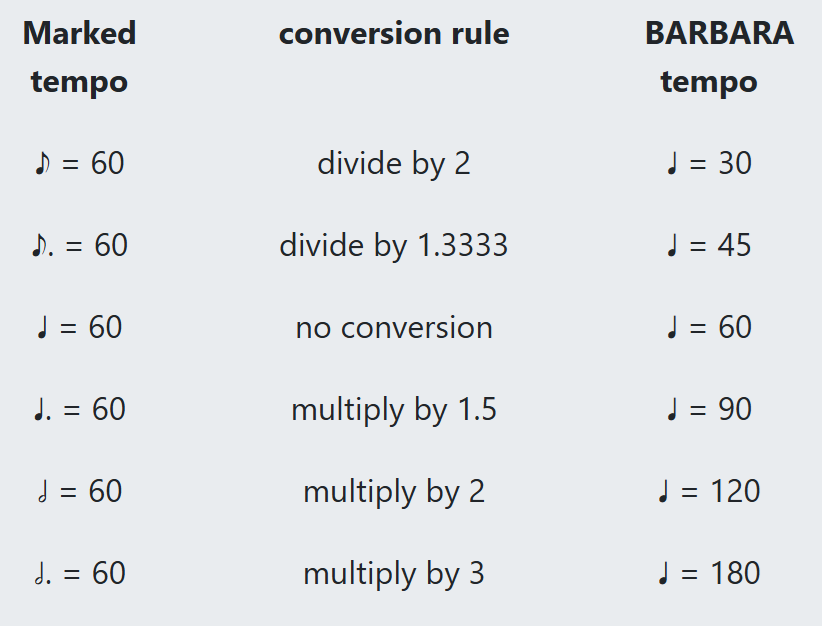
Tempo Tapping
Considering tempo tapping, you should first use the Info button, and ensure that the following selection is made.

After this, you can set the tempo of BARBARA by tapping the following empty area of the screen.

After the first tapping the text KEEP TAPPING emerges, and after the fourth tapping the metronome starts looping using the tapped tempo.

Tempo tapping can be useful when there is no tempo programmed in the sequence of bars that is currently on display. If there is a tempo programmed in a sequence, that tempo will replace the tempo shown on display.
Simple Repeats
There are many ways how you can make BARBARA repeat bars. The simple way is to use the Loop button instead of the Play button when you want to play a sequence of bars.
Then you can program repeats. A single bar will be played several times if you increase the play count by pressing the button for the bar several times.
To program more complicated repeats, BARBARA has the following buttons marked with repeat signs.

When some bars are surrounded by repeat signs, the bars can be played many times. By pressing the button with the right repeat sign over and over, you'll see a number that indicates how many times the bars between the repeat signs will be played.
Here is an example in which two bars are played twice, and then the sequence of these two bars is repeated three times.

The following is the same 'metronomic piece' made without the repeat signs.

Nested Repeats
Nested repeats are repeated bar sequences inside repeated bar sequences. A bar sequence surrounded by the light-colored repeat signs can be included in a sequence surrounded by the dark-colored repeat signs.
The following is an example about a repeated sequence inside a repeated sequence.

The following is the same 'metronomic piece' written without the dark-colored repeat signs.

It is important to note that the dark-colored repeat signs cannot be put inside the light-colored repeat signs. BARBARA will warn you if you try to do 'dark repeats' inside 'light repeats'.
Minutes
If there is a bar whose play count is sufficiently large, BARBARA will show how many minutes the playing of that bar will last. A tempo must be defined earlier in the sequence of bars to make the calculation of play time possible.
In the following picture the 4/4 bar is played 192 times, which lasts 6 minutes when the tempo is 128.

The play times in minutes (and seconds) will be shown only if the play time is one minute or more.
The play count of a bar can be set by tapping the button for the bar as many times as it needs to be played. Alternatively, it is possible to set the play count by doing a long press on the bar button.
After a long press, it will be possible to set the play count of the bar with numbers. If a tempo is defined earlier in the sequence, the following screen is shown, and play count can be set by setting play minutes.

Play Minutes
As explained above, you can specify minutes when you are programming a sequence of bars.
You can also make BARBARA play and loop a sequence a certain number of minutes, regardless what is programmed in the sequence.
A long press on the Loop button will open a so-called dialog with which you can specify how many minutes the metronome is going to play the sequence currently on display.

Sound Settings
You can choose different metronome sounds in Info & Settings.
Then, if you want to control the metronome sound without the sound volume buttons of your device, you must activate Volume Control & Silencing in Info & Settings.
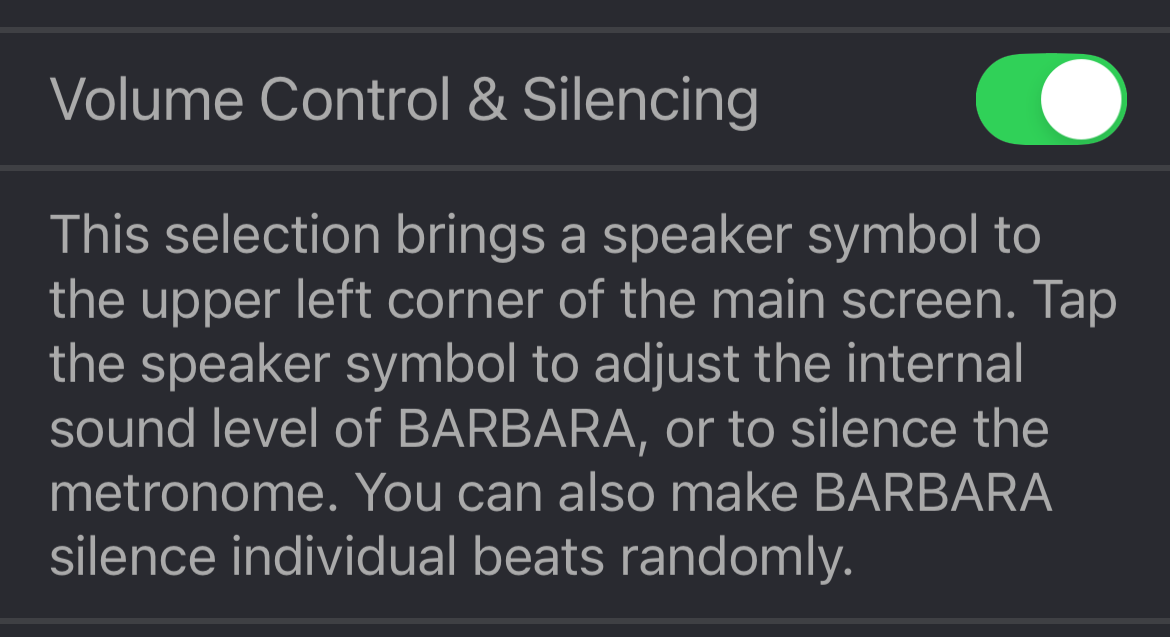
Internal volume control is probably useful for people who want to use the metronome with low volume. You can lessen the metronome sound without affecting the sound level of other apps. You cannot exceed the sound level set with the buttons of the device.
When Volume Control & Silencing is activated, you can also make the metronome silence beats randomly. This means that the metronome plays the rhythm correctly, but sometimes the sound of a beat is not heard.
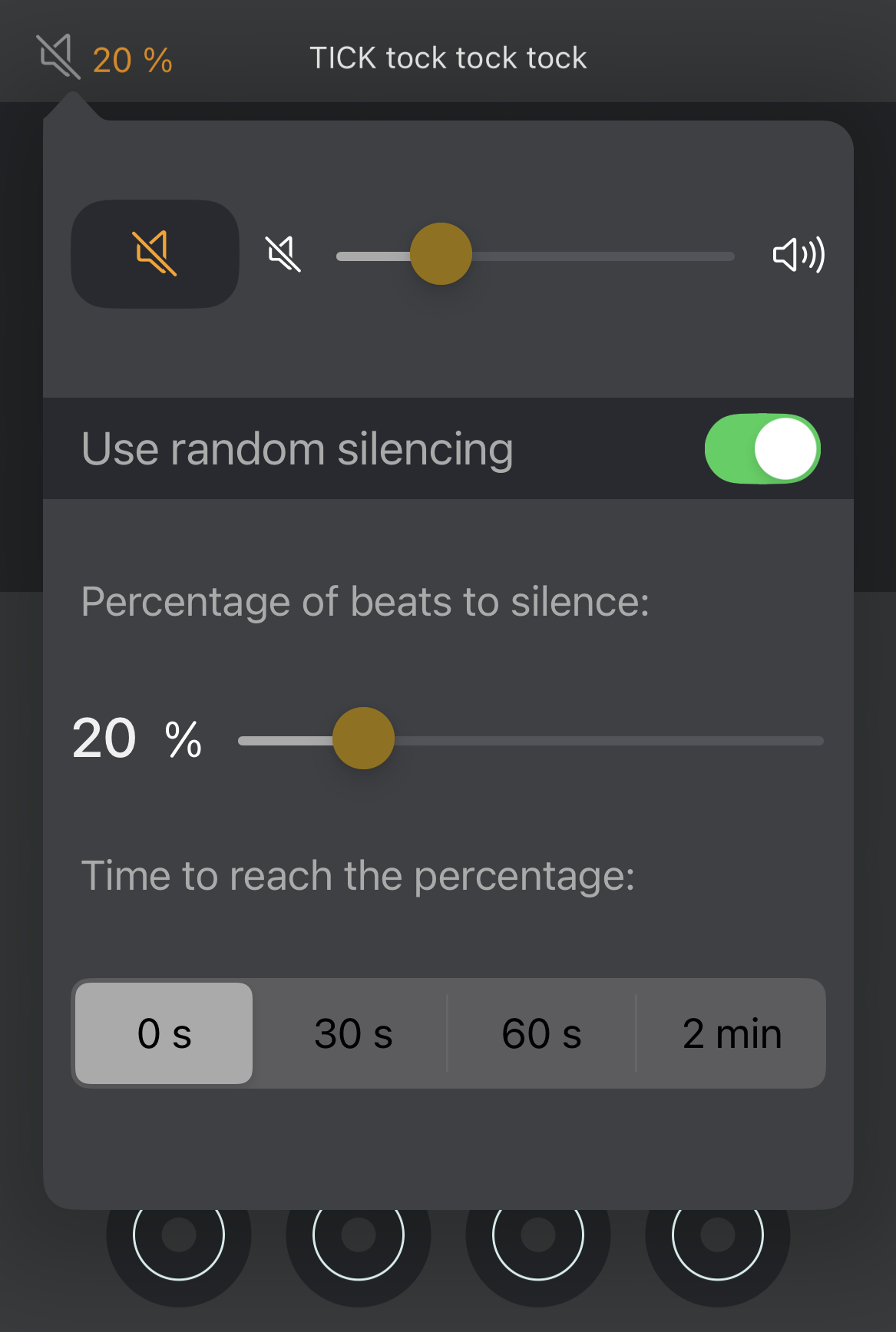
Tempo Tool
In addition to the traditional tempo tapping feature, which is explained earlier on this page, BARBARA has a Tempo Tool, with which you can play with tempo.
You can activate the Tempo Tool by making a long press on the number that shows the current tempo in BARBARA.
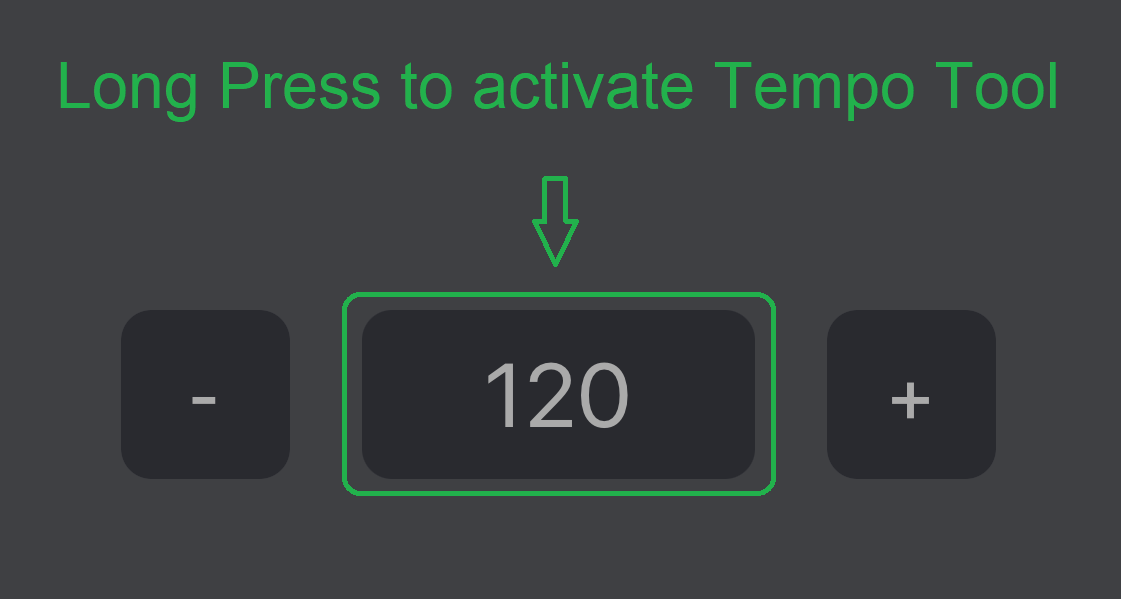
Tempo Tool is actually a quite simple tool: all you can do is just to tap the screen. Tempo Tool records your tappings and displays the tempo and changes in tempo.
You can use Tempo Tool, for example, to measure the tempo of a piece of music if you tap the screen while the music is playing.
Below you can see the Tempo Tool display after the original recording of "Honky Tonk Women" of The Rolling Stones was played, and the screen was tapped during the first 30 bars (120 beats) of the song. You can notice some acceleration of tempo in this great piece of music.
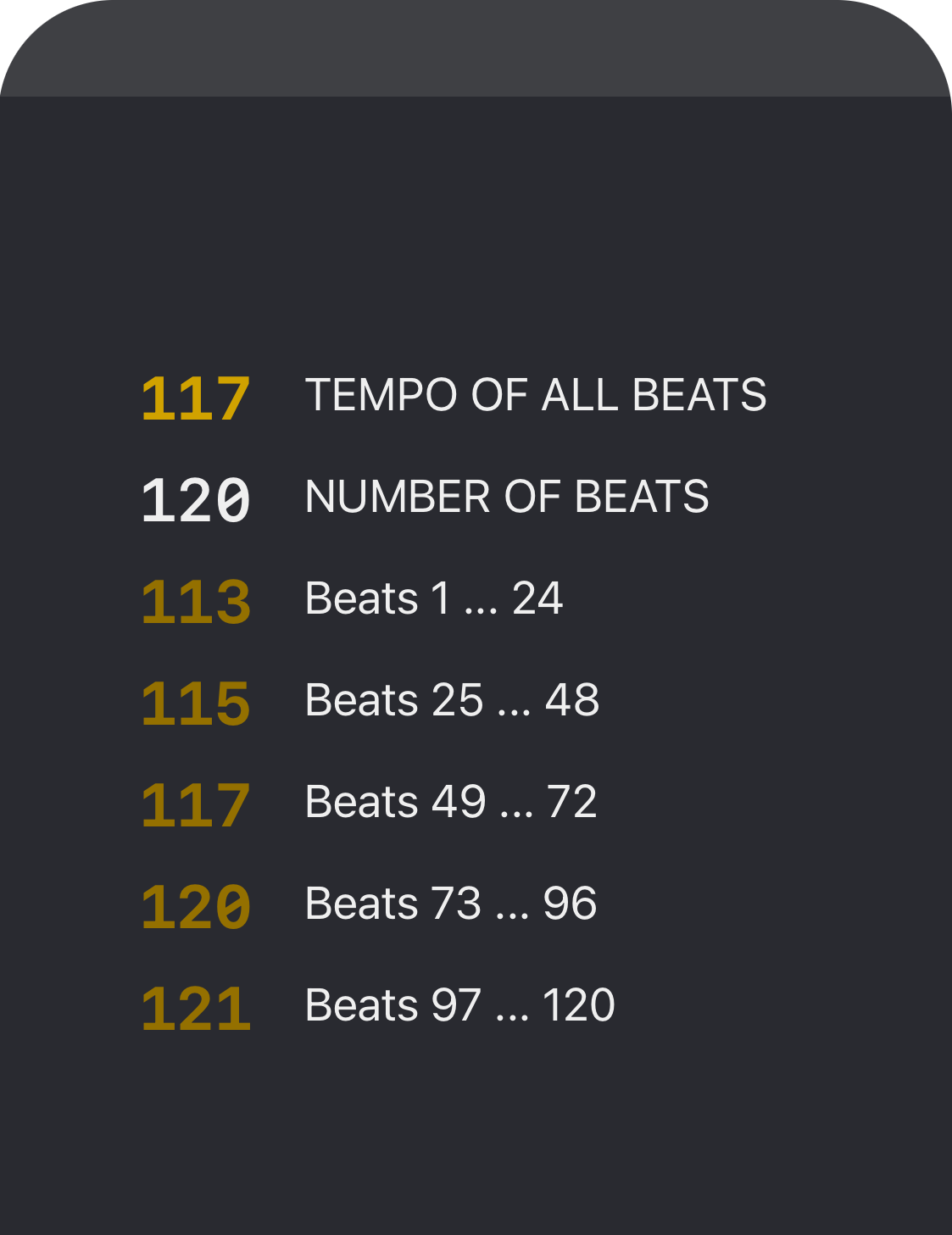
Middle Play
If you have programmed a long sequence of bars, you might sometimes want to play only part of the sequence, and start playing somewhere in the middle of the sequence.
You can mark the bar from which the playing should start by just tapping the bar. BARBARA will show the starting point with a red rectangle.
In the following picture the dark 4/4 bar is tapped, and that is now the point from which playing will start when the Play button is pressed.

You must be careful when you start playing in the middle of a sequence of bars. For example, in the above case the tempo setting would not be performed, and the tempo would be what happens to be currently in tempo display.
Rare Time Signatures
BARBARA has bar buttons for many time signatures, but those buttons do not cover all possible time signatures. To solve this problem, there exist the buttons in which the upper numeral is 1, and the other button is grey in color.
To clarify the logic of BARBARA buttons, let's first describe the produced sounds with words:
The rule is that in the yellowish buttons/bars the first beat is a tick sound. The tick sound can be followed by zero or more tock sounds, depending on which bar is in question.
The grey buttons produce only tock sounds.
By using the two 1/4 buttons, we can create an artificial 4/4 bar, in the following way.

By following this logic, it is possible to make rare time signatures. For example, you can think that the following sequence contains two bars with time signatures 9/4 and 11/4.

They grey buttons can be used in many ways. For example, the following sequences are both valid constructions for a 9/8 bar.


With the grey buttons it is possible to make almost any kind
of time signature. If you use the repeat signs, you can repeat the artificial bars that
are made with two buttons. For example, the following sequence plays four
7/16 bars which are followed by a single 9/16 bar.

Lists
BARBARA maintains lists of sequences of bars. By pressing the Lists button, you can find the following lists.
Named
This list contains the sequences of bars that you have composed yourself. The list is in alphabetical order. You must give a name to the sequence of bars that you have composed in order to make it enter this list. It is possible to delete those sequences that you do not need any more. If you want to modify a named sequence, you have to first select it.
Played
If you need to find a sequence of bars that you have used recently, you can check the Played list. BARBARA automatically lists here the sequences that have been played. The last played sequence is the first in the list.
Demo
This list should help you to learn how BARBARA can be used. The demos show various features of the metronome.
Bin
If you create a new sequence of bars but you do not give it a name, the sequence will be given an artificial name and it will be stored in the Bin list. If you modify a named metronomic sequence, the old version will be stored in Bin. When you delete a piece from the Named list, it will be moved to Bin. The latest additions to Bin are put to the beginning of the list. Old sequences from the end of the Bin list are deleted automatically.
Demos
One selectable list is called Demo. The demos show many possibilities how BARBARA can be programmed and used.
Below you can see a partial list of demos that can be selected to be played by the metronome.
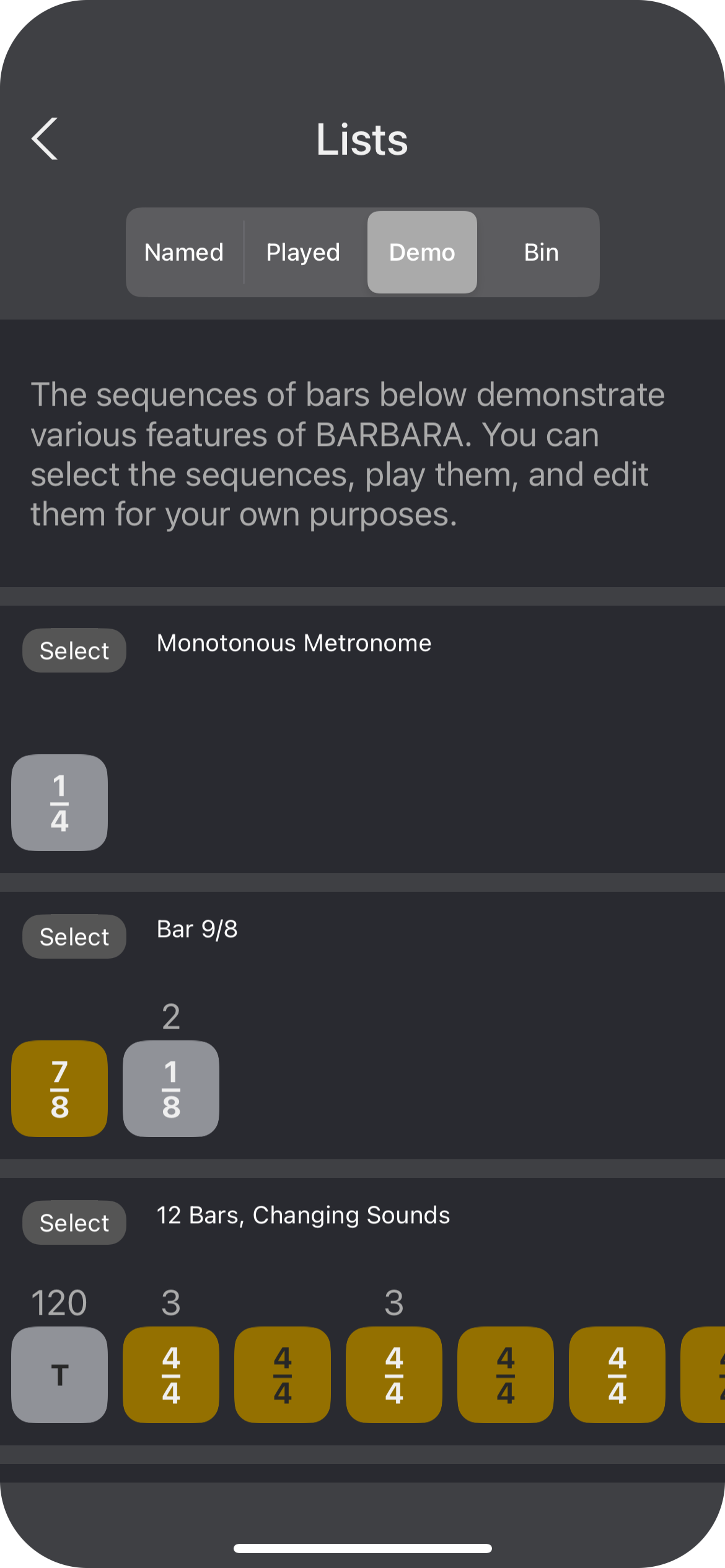
Info & Settings
By using the Info button you will find a long scrollable page that provides information and some buttons and switches with which you can do some settings. The settings are explained on that page.
You can read these instructions on your phone if you press the first Read button in Info & Settings.

Copyright © 2025 Asteroid Zone Software Ltd.
Apple, Apple Logo, iPhone, iPad, and iPod touch are trademarks of Apple, Inc.
App Store is a service mark of Apple, Inc.
Google Play and the Google Play logo are trademarks of Google LLC.






